Aqua Bound Manta Ray Hybrid

The 4-piece Aqua-Bound Manta Ray Hybrid combines the sub-1 kg (32.4 oz) weight with multi-angle ferrule in a travel-friendly package. This carbon/plastic paddle is a great rational choice for packrafting on flat and moving water. It hits the middle ground between strong whitewater-ready paddles and ultralight high-end models—at an attractive price.
Pros
- Low weight
- No wobbling, thanks to individually fitted joints on the factory
- Very lightweight and "warm" ovalized carbon shaft
- Posi-Lok ferrule enables multiple feather angles
- Quite durable blade material
- Excellent price
Cons
- Various sections differ in length quite wildly
- The blades aren’t exceptionally strong or stiff due to thin profile
- Obviously low-cost design and material of the blades
- Inconsistent blade fit over time

Introduction to Aqua-Bound ‘Ray’ paddles
My paddle belongs to the Aqua-Bound ‘Ray’ series, which is intended for flatwater use. There are 3 models:
- Sting Ray has the smallest blades in the series,
- Eagle Ray — for sea kayaking with long and narrow blades,
- Manta Ray is made for intense high angle paddling, with its shorter and wider blades.
The Ray paddles are quite long, ranging from 210 to 250 cm, which hints at their flatwater focusing.

While not intended for whitewater (WW) use, the Manta Ray is the closest of the three to dedicated WW paddles, and it’s especially well suited for heavy boats and packrafts (in 4-piece version, which is reviewed here). It looks like one of the most popular general purpose packrafting blades in the USA. The blade surface area is 676 cm², which falls a tiny bit short of true WW paddles (which are usually found in the 700+ cm² region).
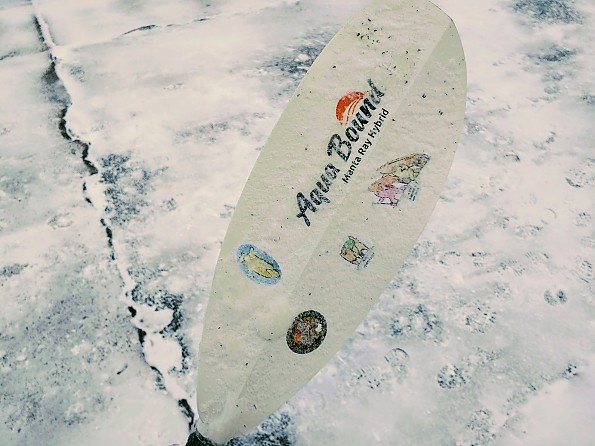
All Ray paddles are equipped with plastic blades made of reinforced polyamide—the most expensive ‘Carbon’ version benefits from carbon-reinforced plastic, and other versions have a tiny bit heavier glass-reinforced plastic blades. Overall, the polyamide blades are a step forward from the cheapest PET material, they are a bit lighter, stronger and more rigid. Carbon-reinforced polyamide appears to be even better in strength, although the weight savings are minimal (some 30 g / 1 oz per blade, or just 9% of the blade weight).
All of those aren’t as lightweight as the top-end blades, found in certain 3-4 times more expensive touring paddles (namely the Whiskey series from Aqua Bound).
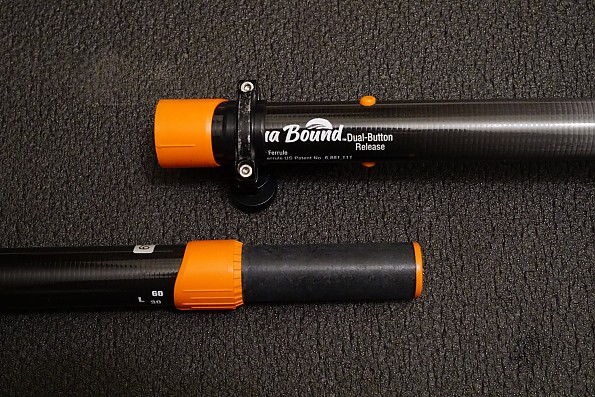
Depending on version, Ray paddles come with glass fiber, aluminum, or lightweight carbon fiber shafts (drip rings included). The carbon fiber shafts come equipped with adjustable Posi-Lok ferrule, allowing for infinite feathering angle adjustment, depending on your paddling style and your leading hand.
My impressions from Manta Ray Hybrid 4-piece paddle
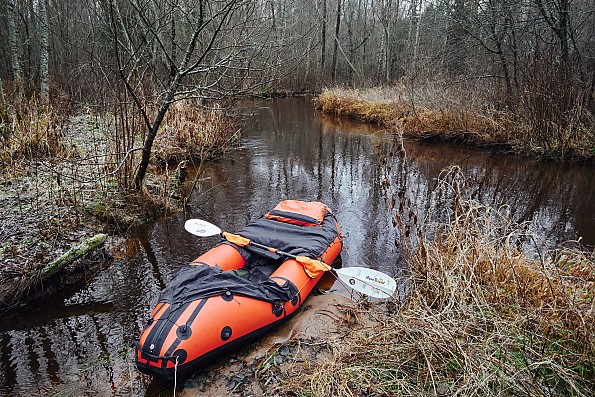
The 4-piece Manta Ray Hybrid paddle combines the glass-reinforced polyamide blades with lightweight carbon shaft, resulting in 920 gram (32.4 oz) measured weight—it’s really good for an adjustable 4-piece paddle in the sub-$200 price range. Here the shaft weighs 110+150=260 grams (9.2 oz) — compared to 490 grams (17.3 oz) in my older aluminum paddle. And each blade is 330 grams (11.6 oz). The carbon-reinforced blade would be about 300 grams (10.6 oz).
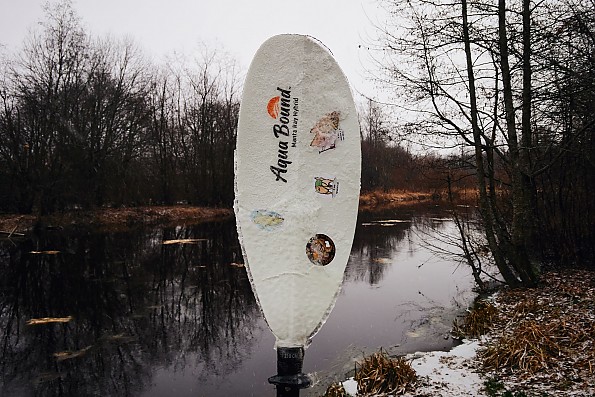
The length of my paddle is 210 cm (typical for all-round packrafting), which is divided into 4 segments: 68.5 + 60 cm shaft and 53 + 53 cm blades. Compared to my older 5-piece 210 cm paddle, that’s quite long and not always convenient for transporting on bicycle in wilderness trips.
The shaft is equipped with the Posi-Lok adjustable ferrule. In most cases I set the 60°R angle, although I can switch to anything between 0 and 90° (L or R), depending on the wind and paddling style (the bigger the feathering angle, the less wind drag you get, but paddling becomes more awkward).
The Posi-Lok ferrule is simple, effective and completely rigid. You need to push two buttons simultaneously to disengage the locking mechanism and pull the paddle halves apart. Unlike many other QR ferrules, there are no sticking handles, which may catch some object and/or disengage on their own.
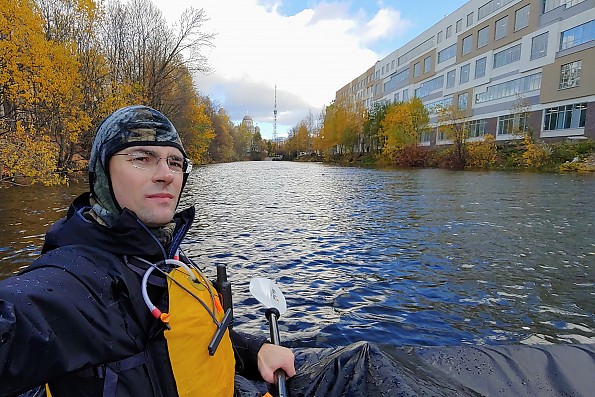
While not absolutely necessary, having the ability to set any feathering angle is handy... at times. In real world use I don’t switch the angle back and forth, because getting used to a new angle isn’t an instant process.
Each shaft portion has a slightly ovalized shape, which allows you to maintain the desired blade position without looking at it. I found it a bit difficult to hold the paddle symmetrically, because there are no visual or tactile clues on the shaft — I fixed that with black duct tape rings (doubling as a small repair kit for my packraft). The shaft is ribbed, some may like it, some not, manufacturer suggests the possibility of polishing the surface with fine sandpaper. In the middle of the shaft I've installed the holder for my Sony RX0 II camera.
In cold weather, the shaft feels warm to hands, being very comfortable even below freezing temperature (with lightweight mittens).
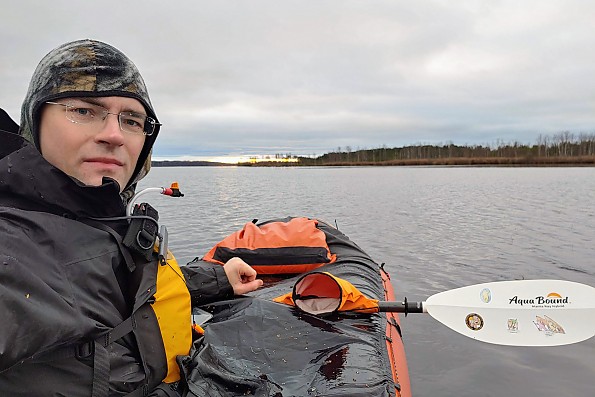
The blades are attached to the shaft using the typical snap button lock. The connection is tight without any wobbling, thanks to individually fitted joints on the factory. Each blade segment is just a single piece of plastic—contrary to many other paddles (like Whiskey-series), where each blade segment also includes a small part of the shaft tube. Most probably, the single piece blade segments allow for better cost saving. The downside—various segments of the paddle differ wildly in length, making the paddle transporting less handy, especially on bicycle. By the way, it’s possible to buy the replacement blades from Aqua-Bound.
The blades themselves have a thin profile, but thanks to dihedral (V) shape, their stiffness and overall strength are adequate for flat water touring. Nevertheless for hardcore paddling athletes the carbon-reinforced blades may appear a better option (stronger and stiffer).
Added in 2024:
The blade fit in the shaft is inconsistent over time. The fiberglass-reinforced polyamide is hygroscopic, it expands in high humidity, so the fit may vary from crazy-tight to wobbling. In 2023 I faced consistent problems with assembling and disassembling my paddle—a fair amount of brute force was required. As per manufacturer instructions I had to file away just a tiny layer of blade material in the joints (using the nail file). But in 2024 season it appeared that during the winter the blade material shrinked, and noticeable play in joints has appeared. I've fixed it easily by applying a thin layer of nail laquer on the blade joints.
Conclusion
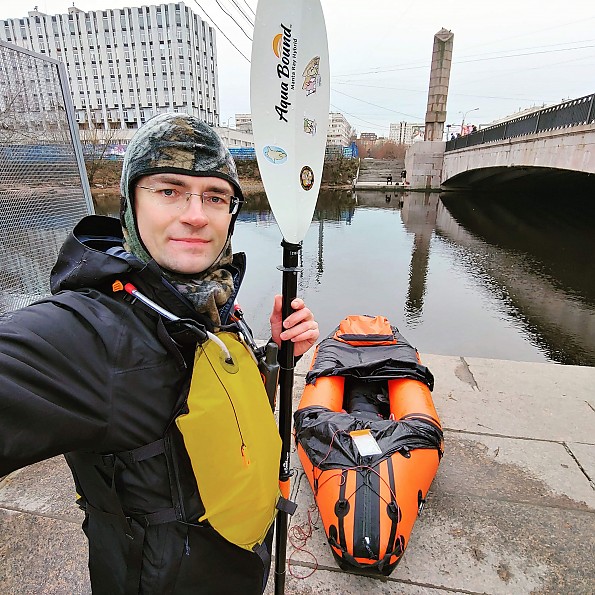
After several packrafting trips, the Manta Ray Hybrid paddle left the impression of a work tool, which will transfer your muscle energy to the boat movement, rather than a fancy accessory. It is of excellent quality, lightweight, with adjustable ferrule, and at a great price—a very tempting option for those who don’t belong to whitewater enthusiasts.
But if you wish to be thrilled by your paddle weight[less], or strength—look elsewhere. I’m pretty much satisfied with mine, although in the future I may become tempted with “strange ideas” about buying a featherweight high-end paddle somewhere in the 700-800 g zone.
Background
This is my second packrafting paddle, and the fourth kayak paddle overall. Since fall 2021 I’ve been using the Manta Ray in my packrafting trips on flat and moving water, at temperatures down to minus 3°C (26°F). This paddle isn’t intended for serious whitewater, and I don’t use it there.
Source: bought it new
Price Paid: 170 USD + free overseas shipping
Your Review
Where to Buy
You May Like
Specs
| Price |
Current Retail: $143.89-$151.89 Historic Range: $96.22-$194.95 Reviewers Paid: $170.00 |

